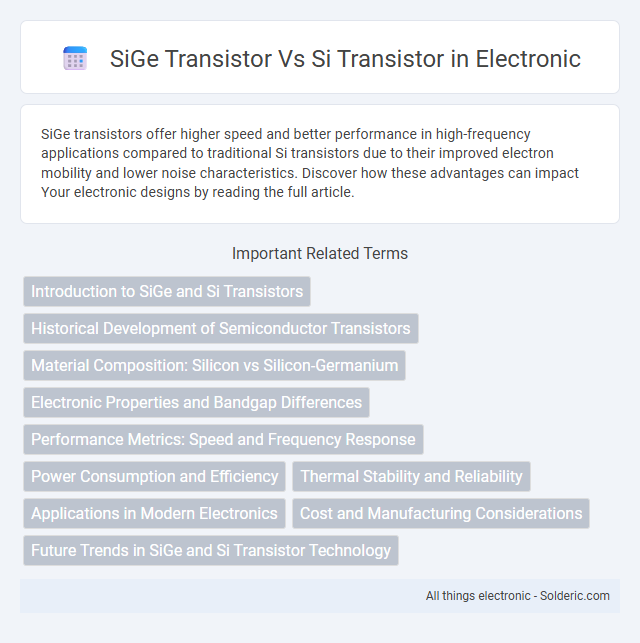SiGe transistors offer higher speed and better performance in high-frequency applications compared to traditional Si transistors due to their improved electron mobility and lower noise characteristics. Discover how these advantages can impact Your electronic designs by reading the full article.
Comparison Table
| Feature | SiGe Transistor | Si Transistor |
|---|---|---|
| Material | Silicon-Germanium (SiGe) alloy | Pure Silicon (Si) |
| Speed | Higher cutoff frequency (f_T), faster switching | Lower cutoff frequency, slower switching speed |
| Noise Performance | Lower noise figure, better for RF applications | Higher noise figure |
| Power Consumption | Typically lower due to higher efficiency | Higher power consumption |
| Thermal Stability | Improved thermal stability | Standard thermal stability |
| Cost | Higher manufacturing cost | Lower manufacturing cost |
| Applications | High-speed RF circuits, mixed-signal ICs, telecommunications | General-purpose analog and digital circuits |
Introduction to SiGe and Si Transistors
SiGe transistors incorporate silicon-germanium alloys in the base region, offering enhanced electron mobility and faster switching speeds compared to traditional silicon (Si) transistors. These advanced devices provide superior frequency response and improved noise performance, making them ideal for high-speed and high-frequency applications. Your choice between SiGe and Si transistors depends on the specific demands of your electronic circuit, such as speed, power efficiency, and integration complexity.
Historical Development of Semiconductor Transistors
SiGe transistors emerged in the 1980s, leveraging silicon-germanium alloys to enhance transistor speed and frequency performance compared to traditional silicon transistors developed in the late 1940s. The introduction of SiGe technology enabled improved carrier mobility and reduced base transit time, crucial for high-frequency applications in telecommunications and RF circuits. Ongoing advancements in epitaxial growth and heterojunction engineering have established SiGe transistors as a key evolution beyond silicon-only devices in semiconductor history.
Material Composition: Silicon vs Silicon-Germanium
Silicon-Germanium (SiGe) transistors incorporate a silicon base alloyed with germanium, enhancing electron mobility and enabling higher speed and frequency performance compared to pure silicon transistors. The addition of germanium creates a strain in the crystal lattice, which improves carrier injection and reduces base transit time, resulting in faster switching speeds. Your choice of SiGe transistors can significantly benefit high-frequency applications and improve overall device efficiency.
Electronic Properties and Bandgap Differences
SiGe transistors exhibit enhanced electronic properties compared to traditional Si transistors due to the incorporation of germanium, which modifies the bandgap energy and carrier mobility. The SiGe alloy has a narrower bandgap than pure silicon, allowing for higher electron and hole mobility, resulting in faster switching speeds and improved current drive capabilities. Your electronic devices can benefit from reduced power consumption and increased performance by leveraging the optimized bandgap engineering found in SiGe transistors.
Performance Metrics: Speed and Frequency Response
SiGe transistors exhibit superior speed and frequency response compared to traditional Si transistors due to their heterojunction structure, which enables higher carrier mobility and reduced base transit time. These characteristics allow SiGe devices to operate efficiently at frequencies exceeding 100 GHz, outperforming conventional Si transistors that typically max out below this range. The enhanced cutoff frequency (fT) and maximum oscillation frequency (fmax) of SiGe transistors make them ideal for high-speed and RF applications.
Power Consumption and Efficiency
SiGe transistors exhibit significantly lower power consumption compared to traditional Si transistors due to their higher carrier mobility and faster switching speeds, which reduce energy losses. Enhanced bandgap engineering in SiGe devices contributes to improved efficiency in high-frequency and high-power applications by minimizing leakage currents. These characteristics make SiGe transistors ideal for energy-efficient, high-performance integrated circuits in telecommunications and power management systems.
Thermal Stability and Reliability
SiGe transistors offer superior thermal stability compared to traditional Si transistors due to their higher carrier mobility and wider bandgap, which reduces leakage currents at elevated temperatures. Enhanced thermal conductivity in SiGe materials contributes to better heat dissipation, improving device reliability under high-power and high-temperature operating conditions. These factors make SiGe transistors more robust for applications requiring consistent performance in harsh thermal environments.
Applications in Modern Electronics
SiGe transistors offer superior high-frequency performance and lower noise figures compared to traditional Si transistors, making them ideal for RF and microwave applications in modern electronics. They are extensively used in wireless communication systems, including 5G infrastructure and radar technologies, where enhanced speed and efficiency are crucial. Si transistors continue to dominate general-purpose digital circuits and power management due to their cost-effectiveness and mature fabrication processes.
Cost and Manufacturing Considerations
SiGe transistors generally incur higher manufacturing costs than traditional Si transistors due to the complexity of integrating germanium into silicon substrates and the need for specialized epitaxial growth techniques. Si transistors benefit from well-established, cost-efficient fabrication processes and widespread availability of materials, making them more economical for large-scale production. Your choice between SiGe and Si transistors may hinge on balancing these cost factors with the performance benefits required for specific applications.
Future Trends in SiGe and Si Transistor Technology
SiGe transistors are poised to drive future trends in high-speed and low-power electronics due to their superior electron mobility and enhanced thermal stability compared to traditional Si transistors. As semiconductor scaling approaches physical limits, SiGe technology offers significant advantages in RF performance and integration with Si-based circuits, making it ideal for 5G and beyond applications. Your adoption of SiGe transistors can enhance device efficiency and support emerging demands in advanced communication and computing systems.
SiGe transistor vs Si transistor Infographic

 solderic.com
solderic.com